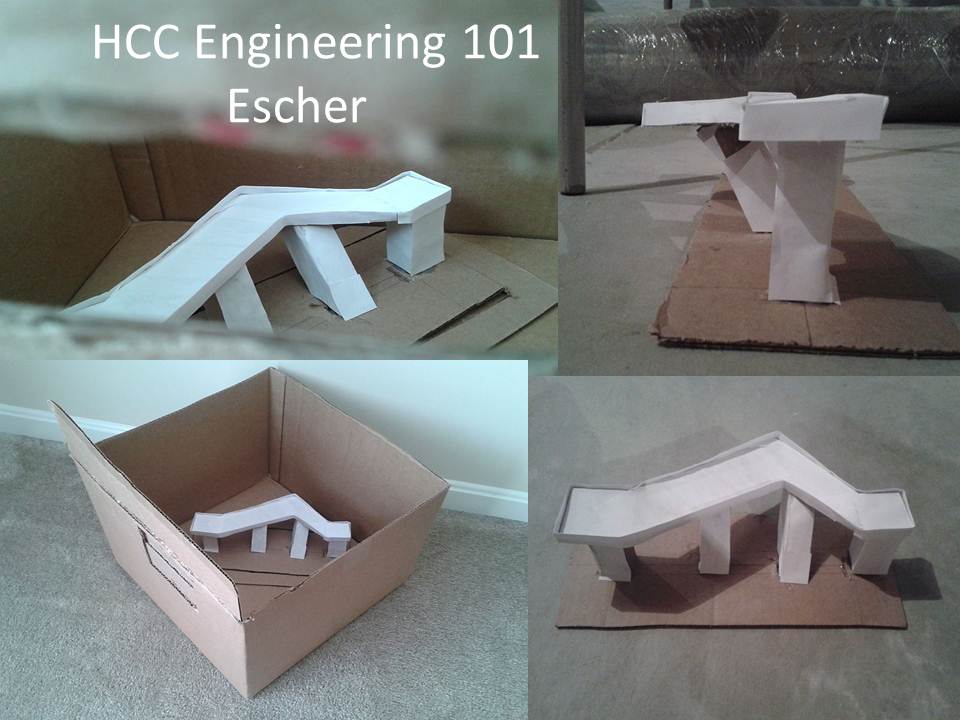Engineering Projects/StrandBeest/Howard Community College/spring2012/p1550MWSY
Problem Statement
[edit | edit source]Design and Create StrandBeest.
Team Members
[edit | edit source]Summary
[edit | edit source]We set out to create a strandbeest. The team started with research of potential designs, and there was a general consensus that the original design by Theo Jansen be maintained. A general scale was agreed upon based on Jansen's golden numbers. The next major decision the group had to agree upon was what materials to use. We decided that because we had access to light wood and a CNC router that would be a good place to start.
Poster
[edit | edit source]
Story
[edit | edit source]The group assembled and decided that the best route to tackling the new project was to research the mechanical workings of the leg assemblies. We made several working models and felt it was time to move on to design. We had access to both wood and a large CNC router so we decided that wood might be the best material for our design. We created a CAD drawing with each of the pieces of the assemblies we needed. Once everything was set and the toolpaths were added, we made a test cut with the router. This showed that we needed to add small bridges to hold everything together on the table. With bridges added, we began the cutting of the parts. The bridges were cut by the machine on the second pass, so they would be thin and easy to remove.
We also began modeling and testing materials for the crankshaft. This is the area we found the most difficulty. The flat design of the leg assemblies limited the material we could use to prevent a gap between pieces of the leg. The material and that which was holding it together had to be strong enough to hold the weight of the assembly and sturdy enough to do it while moving. Ultimately the crankshaft did not get finished within the time frame of this project.
Decision List
[edit | edit source]Week 0
- Researched the design of the leg assembly of the strandbeest.
Week 1
- Dimensions of the strandbeest were hammered out within the group.
- Materials and tasking within the group to acomplish several tasks
- Gathered supplies that are going to be used for this project
- Made cardboard mock-up of linkage.
Week 2
- Made designes for pieces to be cut in 123D and AutoCad
- Imported designs into EnRoute and made adjustments to arrangement.
- Encountered some trouble importing the files into EnRoute from AutoCAD. Parts of the drawing were not present in the imported file. Some experimentation showed that the files needed to be both downgraded to an earlier file format and all arrayed elements had to be exploded and reduced to one of each part in AutoCAD before importing. Each part can then be arrayed or nested in EnRoute.
- Set toolpaths for cutting in the imported .ROU files and exported them to .CNC files for the router to retrieve.
Week 3
- Made a test cut with the CNC router. Determined that bridges were necessary to keep the parts still on the machine.
- Added bridges to both files. These are .5 inch wide connections between the pieces and the board that are left by the cutting table to hold things together. This is useful with intricate cuts of small parts that could get sucked into the dust collector.
- Made actual cuts of parts.
- Assembled a pair of legs to test the movement. The legs touched at the toe and bumped into themselves at the farthest reaches of the rotation. Adjustments were needed.
Week 4
- Made a reduction of about 1 inch to the crank radius which caused the leg to move much more smoothly.
- Drew up 3D model of crankshaft for continued design work.
Material List
[edit | edit source]1. 2 sheets of 5mm Luann wood, 4 foot by 8 foot.
2. 1/2 " wooden dowel 3 foot
Software List
[edit | edit source]AutoCAD 2012 was used to do the design of the wooden parts of our StrandBeest. AutoCAD is computer assisted drawing software. Its purpose is precise design.
EnRoute 4 was then used to import the AutoCAD files (saved as .DXF) and prepare for output to the MultiCAM 3000. EnRoute is CAM software. The function of CAM is computer assisted manufacturing. It communicates your drawings and the details of how your parts are to be cut/drilled to the machine which does the cutting. In EnRoute, you can import CAD files, edit them, draw from scratch, set toolpaths, and select cutting tools and order. EnRoute can communicate with and export executable information to most CNC routers, laser cutters, water cutting machines, 3D printers and such equipment.
123D was used to create a 3D model of the crankshaft
Time
[edit | edit source]41 hours and 13 minutes
Tutorials
[edit | edit source]Next Steps
[edit | edit source]The crank shaft remains the main hurdle at the moment. Possibly consider using circles instead of the arms that I have already cut. This will make them more sturdy and provide counter balance. Once that is ironed out the next clear step is assembly of the Beest.
The working Beest will need to be powered. Wind is the obvious choice, but other avenues could be interesting as well.
